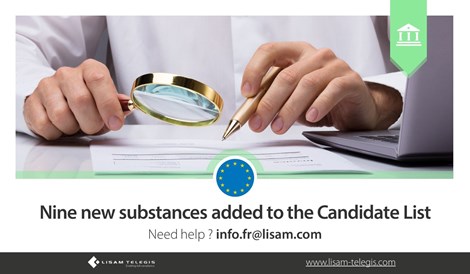Nine new substances added to the Candidate List - January 2023
Nine new substances added to the Candidate List - January 2023
mercredi 18 janvier 2023
 Nine substances have just been added by the European Chemicals Agency (ECHA) to the Candidate List of Substances of very high concern (SVHC) for authorisation.
Nine substances have just been added by the European Chemicals Agency (ECHA) to the Candidate List of Substances of very high concern (SVHC) for authorisation. • 1,1'-[ethane-1,2-diylbisoxy]bis[2,4,6-tribromobenzene] (CAS 37853-59-1 / EC 253-692-3) : Inclusion for its vPvB properties
• 2,2',6,6'-tetrabromo-4,4'-isopropylidenediphenol (CAS 79-94-7 / EC 201-236-9) : Inclusion for carcinogenic properties
• 4,4'-sulphonyldiphenol (CAS 80-09-1 / EC 237-222-4) : Inclusion for its endocrine disrupting properties for humans and the environment and its reproductive toxicity for humans
• Barium diboron tetraoxide (CAS 13701-59-2 / EC 237-222-4) : Inclusion for human reproductive toxicity
• Bis(2-ethylhexyl) tetrabromophthalate covering any of the individual isomers and/or combinations thereof (CAS - / EC -) : Inclusion for its vPvB properties
• Isobutyl 4-hydroxybenzoate (CAS 4247-02-3 / EC 203-615-4) : Inclusion for its endocrine disrupting properties for humans
• Melamine (CAS 108-78-1 / EC 203-615-4) : Included for its equivalent level of concern with probable serious effects on human health and the environment
• Perfluoroheptanoic acid and its salts (CAS - / EC -) : Inclusion for its PBT, vPvB, human reproductive toxicity, for its equivalent level of concern with probable serious effects on human health and the environment
• reaction mass of 2,2,3,3,5,5,6,6-octafluoro-4-(1,1,1,2,3,3,3-heptafluoropropan-2-yl)morpholine and 2,2,3,3,5,5,6,6-octafluoro-4-(heptafluoropropyl)morpholine (CAS - / EC 473-390-7) : Inclusion for its vPvB properties
You may have new legal obligations. Find a few explanations about the Candidate List hereafter:
Candidate List: what is it really about?
A few words about the process first:
The “Candidate List of substances of very high concern for Authorisation”, better known as the “Candidate List”, is a list of substances that have been formally identified as “substances of very high concern” (SVHCs) according to precise criteria and a complex process described in the REACH Regulation.
The inclusion process itself involves an “Intention” (published in a “Registry of Intentions”) followed by the submission to the European Chemicals Agency (ECHA) of a dossier in a specific format, a public consultation, and, finally the Agreement of the Member States Committee (MSC).
The last step of the process for a specific substance consists in updating the Candidate List published on the ECHA website. This step, and this step only, is triggering the obligations associated with the fact that the substance belongs to the Candidate List.
No publication in the Official Journal is taking place at this stage. Later, when the substance is finally subject to authorisation, a regulation will be published to announce this new status with associated deadlines and possible exemptions, via inclusion of the substance in Annex XIV.
When a substance becomes subject to authorisation it remains included in the Candidate List and the corresponding duties continue to apply.
The obligations:
We will not give all the details here. Let’s just mention that companies must provide information to ECHA about the presence of SVHCs in articles by means of REACH registrations or specific notifications. They must also inform their customers and even the general consumer on request when articles contain such substances above 0,1%.
The purpose:
Identified SVHCs are doomed to be subject to authorisation, sooner or later. In other words, they will be banned from the European Economic Area whenever possible. Only very specific uses will be admitted when the benefits outweigh the risks to health and environment. So, why are there duties associated with the Candidate List? Why not just accelerate the overall authorisation process?
The way we see it, the main reason is the general quest for transparency. All over the world, people are claiming their “right to know” and their “right to make informed decisions”. We want to know what we buy. We more and more want to know the impact of our waste on our environment.
The Agency is maintaining a public list called “Information on Candidate List substances in articles” on its website.
Since January 2021, companies also have to notify products containing SVHCs to ECHA’s SCIP database on substances of concern in articles and products. The database aims to ensure transparent information on articles containing hazardous chemicals throughout their whole lifecycle.
Although still quite imperfect, such official transparency tools are most certainly also serving Industry’s best interests. We all know the possible consequences of rumours about the supposed hazards of a substance and the inappropriate use of words such as “toxic” and “dangerous”. Best is to disseminate validated information before the damage is done and can never be repaired.
You may also consult the following page of the ECHA website: see here
